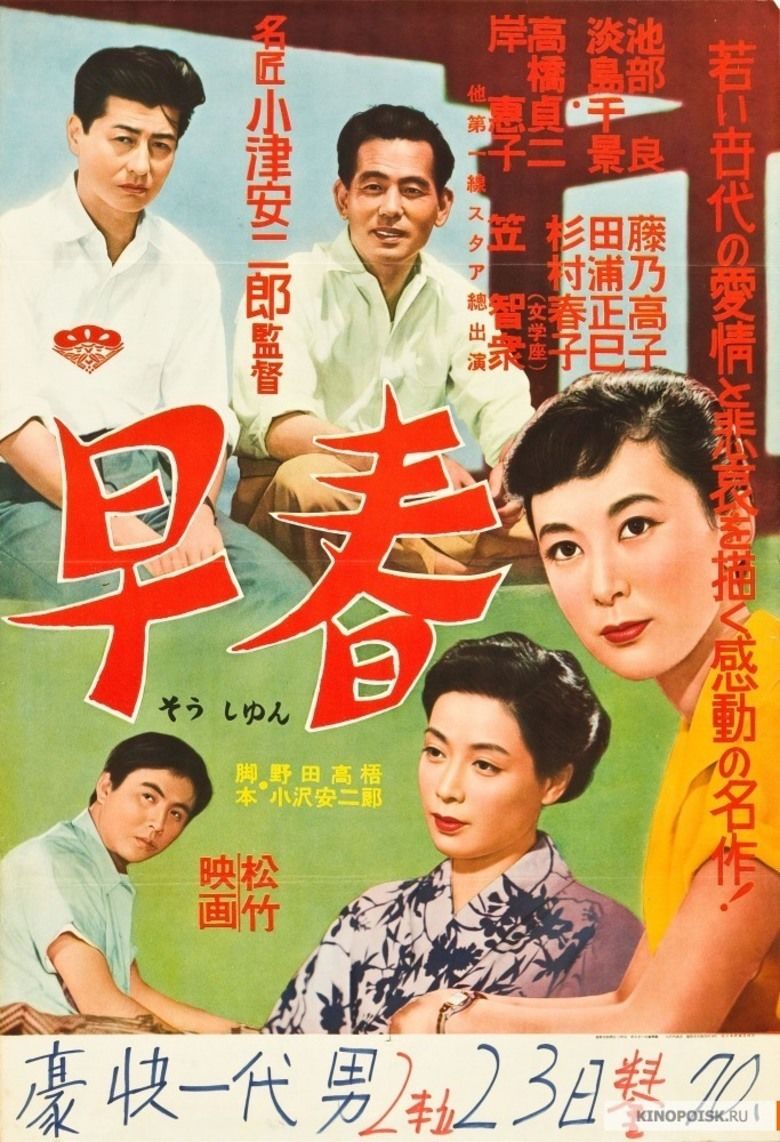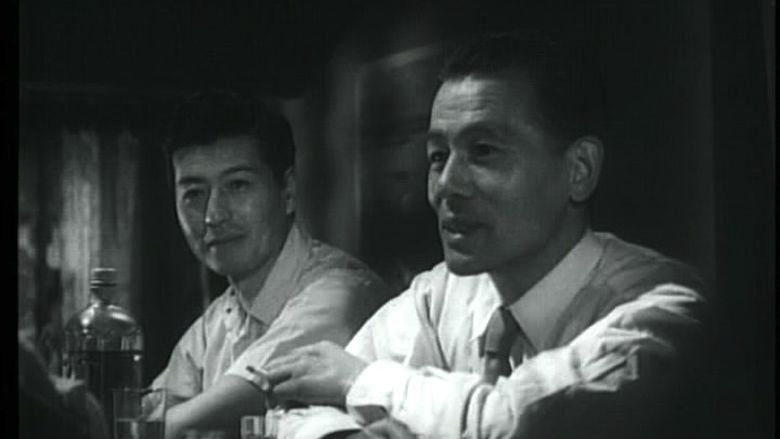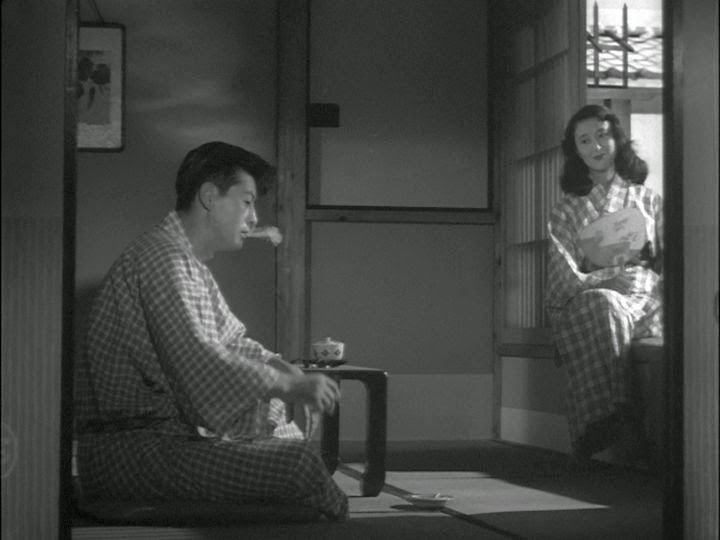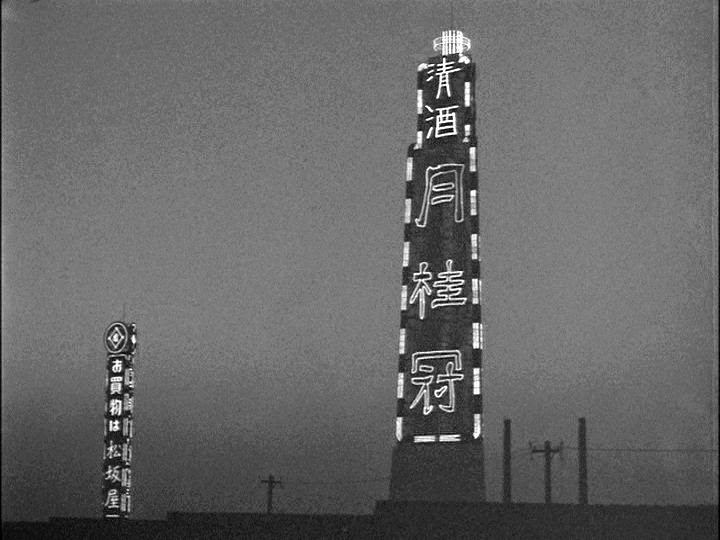Early Spring (1956 film)
8.8 /10 1 Votes
8.1/10 Letterboxd Director Yasujiro Ozu Screenplay Yasujiro Ozu | 8/10 IMDb 100% Rotten Tomatoes Genre Drama Duration Country Japan | |||||||||||||||||||||||||||||||||
 | ||||||||||||||||||||||||||||||||||
Writer Kogo Noda , Yasujiro Ozu Release date January 29, 1956 (1956-01-29) Genres Drama, Romance Film, Art film, World cinema, Japanese Movies Cast (Masako Sugiyama), Takako Fujino (Terumi Aoki), Ryô Ikebe (Shoji), Daisuke Katô , (Chiyo Kaneko), (Yukiko Kawai)Similar movies Rurouni Kenshin , The Ledge , Vacancy , Boccaccio '70 , Blue Sky , Shinsengumi: Assassins of Honor | ||||||||||||||||||||||||||||||||||
Early spring soshun 1956
Early Spring (早春, Sōshun) is a 1956 film by Yasujirō Ozu about a married salaryman (Ryō Ikebe) who escapes the monotony of married life and his work at a fire brick manufacturing company by beginning an affair with a fellow office worker (Keiko Kishi). The film also deals with the hardships of the salaryman lifestyle. "I wanted," Ozu said, "to portray what you might call the pathos of the white-collar life."
Contents

With a runtime of 144 minutes, Early Spring is Ozu's longest surviving film, and his penultimate shot in black and white.

Plot

Office worker Shoji Sugiyama (Ryō Ikebe) wakes and goes about his morning routine, attended by his wife, Masako (Chikage Awashima), before commuting to his job in the Tokyo office of a fire brick manufacturing company.
During a hiking trip with office friends, Shoji spends time alone with a fellow worker, a typist nicknamed "Goldfish" for her large eyes (Keiko Kishi). After the trip Goldfish makes advances to Shoji and the two begin an affair. Masako suspects something is amiss but is reluctant to confront her husband. After Shoji fails to mark the anniversary of their son's death, he and Masako become progressively estranged.

The friends, too, suspect something is transpiring between Shoji and Goldfish. They confront Goldfish, advising her not to come between a married couple. Aggrieved, Goldfish visits Shoji late in the night. Masako, convinced that her suspicions have foundation, demands Shoji tell her the truth about his relationship with Goldfish. Shoji does attempt to lie, and the next morning Masako leaves the marital home to stay with her mother.

Shoji relocates to his company's office in the provincial town of Mitsuishi. Masako eventually travels to Mitsuishi and the couple is reunited. They promise to forget their past troubles and strive for marital happiness.
Cast

Production

After the release of Tokyo Story, Ozu was called upon to assist his friend, the actress Kinuyo Tanaka, in completing her second film as director, The Moon Has Risen. By the time production on Early Spring began, Ozu had been away from the director's chair for three years: a substantial hiatus for someone who had averaged a picture a year since the end of the Second World War. In the meantime, the "Ofuna-cho" or "home drama", the genre of film with which Ozu was most closely associated, had decreased in popularity. Ozu maintained that "the traditions of the Ofuna-cho are the result of 30 years. They are not going to fall in one morning". Nevertheless, under pressure from his studio, Ozu made several concessions to modernity. He cast mostly young and popular actors, and, with long-time collaborator Kōgo Noda, delivered a script devoid of the dominant parental figures that were a fixture of his previous films. The theme of communication problems between generations, another familiar trope of Ozu's work, was also absent. In its place was the theme of disillusionment with life as a salaryman. "I wanted to have a go at representing their lifestyle," said Ozu. "The thrill and aspirations one feels as a fresh graduate entering society gradually wane as the days go by. Even working diligently for thirty years doesn't amount to much."
Early Spring makes use of temporal ellipses, gaps in the narrative into which the audience is invited to project meaning, which are common in Ozu's films. For example, after Shoji and Goldfish begin their fling we do not see them alone together until Goldfish visits Shoji's home. Since this is after the pair's friends have confronted Goldfish, we, like the friends, do not know for certain if the affair is ongoing. Ozu also omits potentially melodramatic moments: Masako does not discover her husband's lipstick-stained handkerchief on screen, but instead recounts the discovery to her mother.
Reception
Rotten Tomatoes reports 100% approval for Early Spring, with an average rating of 8/10. In a highly positive review, Nora Sayre of The New York Times wrote that the work "conveys the claustrophobia of office life better than any other film I've seen", and that "Ozu finds dramatic depths in quiet, ordinary lives. And during the time that you spend with these people—the span of the movie—you really feel that you've come to know them well, to understand why their relationships do or don't develop." Sayre wrote that the characters' "emotions or hidden instincts are brilliantly revealed through small details".
In The New Yorker, Richard Brody argued that "Ozu’s despairing view of postwar Japan looks as harshly at blind modernization as it does at decadent tradition." Don Druker of the Chicago Reader called the film a "casual yet meticulously detailed reconstruction of Japan's routinized white-collar milieu". Despite the praise, it is not one of Ozu's most renowned works.
Home media
In 2012, the BFI released the film on Region 2 DVD, along with of Tokyo Twilight and Woman of Tokyo, as Three Melodramas.
References
Early Spring (1956 film) WikipediaEarly Spring (1956 film) IMDbEarly Spring (1956 film) LetterboxdEarly Spring (1956 film) Rotten TomatoesEarly Spring (1956 film) themoviedb.org
